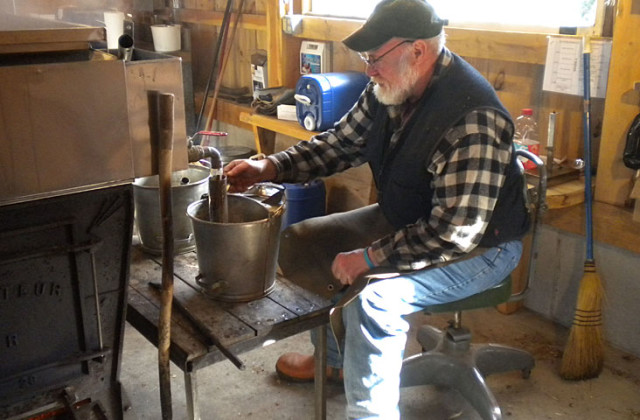It’s Only Natural—March 2016
Art, Science and Nature in a Rite of Spring
By Hans M. Carlson
Last Sunday’s minus 19 degrees was a record, and I love that kind of cold, so I took a walk in the woods as soon as the sun rose. I came out at the east gate of Great Mountain Forest, and decided to look in the sugarhouse since sapping had been on my mind all morning. As cold as it was, the temperature was going to rise sharply, so the coming week might well bring the start of one of my favorite seasons.
I stood outside the sugarhouse looking at the maple just outside the door, trying to judge its readiness. People have been asking how this strange winter will affect the sugaring, and you might expect that the warm winter would throw off the trees’ natural cycles. You might also think that this would disrupt all the usual human calculations, but the truth is that there are very few usual calculations to be made. There is always mystery, not to mention a fair amount of educated guessing, in judging when the sap will come and how good a season it will be.
Sapping happens during a period of a few weeks, between mid-February and early April, when temperature fluctuations cause osmotic pressure to increase sap flow. This pumping action is caused both by expanding and contracting sapwood, but also because cooled sapwood cells dissolve carbon dioxide. When the temperature warms again, the cell walls and the carbon dioxide expand, increasing pressure within the tree. By drilling shallow holes into the sapwood, you can take off a small portion of the flowing sap. Red squirrels do the same by nibbling at the buds, and cold, fresh sap is a refreshing drink.
The sap is sweet in this early season because the trees have not started to produce bitter-tasting chlorophyll. Starch stored in the roots over winter is converted to sugar and is moved upwards through the trunk to provide energy for leaf-out on the outer branches. All these mechanisms are well understood, and yet it’s the mix of sun and cloud, air and soil temperature that awakens the trees. Judging when all this will happen is much more an art than a science.
The rollers on the sugarhouse door protested when I opened them in the bitter cold. Soon the air inside would be filled with sweet-smelling vapor, but that day the only steam rising was my breath. The cast-iron arch looked very cold, and there was frost on some of the shiny stainless steel pans. The fire would be roaring in a week or so, however, and it would be time for the science of sugaring.
A bit of sap, viewed through a refractometer, reveals the sugar content. This is usually between 2 and 4 percent, with higher readings coming early in the run and then falling off afterward. Some trees hold higher sugar content for longer than others, but the aggregate drops during the season. Knowing the sugar content tells the sugar maker how many gallons of sap it will take to produce a gallon of syrup. Anywhere from 25 to 40 gallons is normal.
The sap-to-syrup ratio, in turn, makes it possible to calculate how much wood will be needed and how long it will take to empty the sap tanks. You wouldn’t think that the difference between two and four percent would change things that dramatically, but it can mean the difference between going home at five o’clock and boiling long after dark.
A hydrometer is used to measure the specific gravity of the boiling sap, and at about 219 degrees (depending on barometric pressure) it becomes syrup. Tight control is needed to make sure the finished product is not watery, but also does not crystallize. Letting the boiling syrup go past the crystallization point in the pan is the worst disaster that can happen in the sugarhouse, so care and precision are of the essence.
All this is a kind of cooking chemistry, and yet there is mystery here too. The sap still asserts its identity on the final product, as each run undergoes the caramelization process in the boiling pan, giving a different color to the syrup. John Burroughs once called the sap run a “sequel of the bitter frost; the sweet goodbye of winter,” and I would add that the finished syrup is one of the best results of combining art, science and nature in a rite of spring.
Photo by Hans M. Carlson: Master Sugarer Jody Bronson draws off syrup into a hydrometer jar to test its density at the Great Mountain Forest sugar house.

